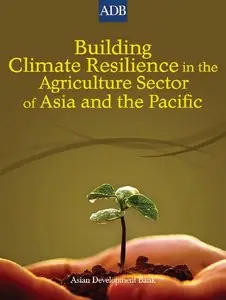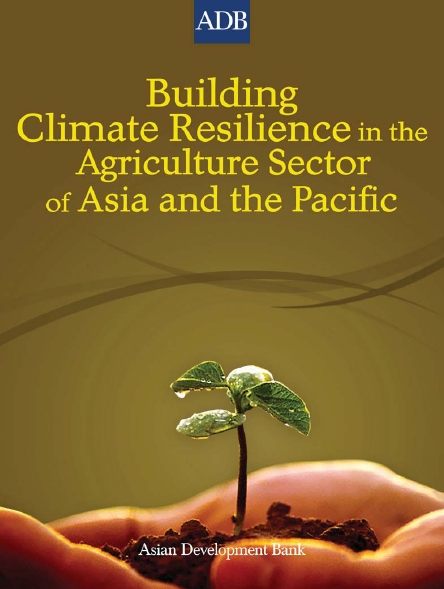Building Climate Resilience in the Agriculture Sector of Asia and the Pacific
ADB | 2009 | ISBN: 9789715618274 | 322 pages | PDF | 2 MB
ADB | 2009 | ISBN: 9789715618274 | 322 pages | PDF | 2 MB
This study, carried out by the International Food Policy Research Institute (IFPRI), uses predictions of global climate models to develop scenarios to 2050 for Asia and to derive implications for food security.
The study recommends cost-effective adaptation responses that could build greater climate resilience into the agriculture sector in Asia and the Pacific.
Contents
Acronyms and Abbreviations
Foreword
Acknowledgments
Executive Summary
Overview
Agricultural Profile of Asia and the Pacific
Climate Change Trends
Resilience as the Conceptual Framework
The Role of Adaptation
Important Synergies between Adaptation and Mitigation
Conclusions and Priority Actions
Chapter I. Introduction and Overview
Introduction
Conceptual Framework
The Three Dimensions of Vulnerability
Exposure
Sensitivity
Adaptive Capacity
Implementation of the Conceptual Framework
Actions to Reduce Vulnerability and Build Resilience
Adaptation
Mitigation
Outcomes of Improved Resilience
Limitations of the Modeling Undertaken
Summary
Chapter II. Vulnerability of Countries in Asia and the Pacific to Climate Change
Factors Affecting Vulnerability to Climate Change
Results of Vulnerability Assessments for Asia and the Pacific
Bangladesh
Pakistan
Cambodia
Viet Nam and Mekong Delta
The People’s Republic of China and India
Central Asia
Pacific Island Countries
Vulnerability Indicator for Asia and the Pacific
Summary
Chapter III. Impacts of Climate Change on Agriculture and Food Security
Introduction
Components of the Modeling Framework
Crop Modeling
Climate Data
Other Agronomic Inputs
Linking Crop Model Results to IMPACT
Modeling Results
Effects of Climate Change on Yields
Climate Change Impacts on Agriculture and Human Well-being
The Costs of Adaptation
Effects of Trade Liberalization and Increased Protection
Impacts of Sea-Level Rise on Crop Area in Asia and the Pacific
Limitations
Summary
Chapter IV. Adaptation Policies, Investments, and Institutional Reforms
Introduction
Local Coping Strategies
Central Asia
East Asia
South Asia
Southeast Asia and the Mekong Subregion
Innovative Adaptation to Climate Change
Changes in Agricultural Practices
Changes in Agricultural Water Management
Agricultural Diversification
Agricultural Science and Technology Development
Agricultural Advisory Services and Information Systems
Risk Management and Crop Insurance
Strengthening Ongoing Development Initiatives
Secure Property Rights
Agricultural Market Development
Agricultural Policies
Trade Policies
Other Environmental Policies
Social Protection
Financial Markets: The Role of Microfinance
Disaster Preparedness
Implementing Climate Change Adaptation Policies
Mainstreaming Climate Change and Adaptation into Development Planning
Financing Adaptation
The Role of the CGIAR in Climate Change
Significant New Investments
Cost of Adaptation
Global Adaptation Costs
Adaptation Costs for Asia and the Pacific
Reforming Climate Change-Related Governance and Institutions
Civil Society
Government Institutions
Regional Organizations
Development Agencies and Donors
The Private Sector
Adaptation Policy Recommendations
Chapter V. Opportunities for Mitigation and Synergies with Adaptation and Sustainable
Development
Introduction
Global and Regional Emissions Trends and Sources
Agricultural Soils
Livestock and Manure Management
Rice Cultivation
Other Agricultural Sources
Mitigation Strategies in the Agriculture Sector
Carbon Sequestration
Bioenergy
On-Farm Mitigation
Summary of Technical Mitigation Potential
Economic Potential of Mitigation Options
Summary of Economic Mitigation Potential
Institutional Barriers to Mitigation in Agriculture in Asia and the Pacific
Integrating Mitigation and Adaptation in Sustainable Development Pathways
Synergies between Mitigation and Adaptation
Combating Economic Losses in the Pursuit of Mitigation Strategies
Generating Income from Carbon Markets and Ensuring Smallholder Participation
Summary
Chapter VI. Conclusions and Policy Recommendations
Introduction
Agriculture’s Role in Asia and the Pacific
Climate Change Trends
Vulnerability to Climate Change in Asia and the Pacific
Climate Change Impacts on Agriculture
Adaptation Measures
Synergies between Adaptation and Mitigation
Conclusions and Priority Actions
Negative Impacts on Agricultural Production and Food Security
Assistance Should be Targeted Toward Those Most Vulnerable to Climate Change
Key Adaptation and Mitigation Measures Need to be Undertaken Now
International Trade is an Important Mechanism for Sharing Climate Change Risk
Regional Cooperation among Governments in Asia and the Pacific Needs to be Improved
Agriculture Needs to Form Part of International Climate Change Negotiations
Appendixes
Appendix 1: Additional Tables
Appendix 2: List of ADB’s Developing Member Countries, by Subregion
Appendix 3: List of Regional or Subregional Groupings Involving Countries in Asia and the Pacific
Appendix 4: Survey of Climate Change Impact Models
Agronomic-Economic Simulations
Agroecological Zone Analysis
Ricardian Models
Climate Change Impacts on Agriculture in Asia and the Pacific According to Global Assessments
Appendix 5: IFPRI’s Climate Change Modeling Framework
Approach
Modeling Overview
Adaptation Needs and Potential
Modeling Climate Change Impacts on Agriculture
The IMPACT 2009 Model
Spatial Aggregation Issues
Modeling the Costs of Adaptation to Climate Change
How We Represent the Future
References
Glossary
with TOC BookMarkLinks



